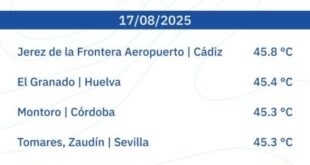Spain Water Alert: Mediterranean temperatures soar; jellyfish alerts grow
Credit: viktor95, Shutterstock
The Mediterranean Sea is boiling like never before, with Spanish buoys in Mallorca and Menorca recording water temperatures above 30 °C in mid-August 2025. Scientists say this is the most intense marine heatwave on record. It threatens marine life and can cause dangerous jellyfish blooms near popular beaches. The western Mediterranean, from Mallorca to Malaga to Valencia, has become bathwater. This alarms holidaymakers, climate experts and fishermen alike.
Mediterranean “bathwater”: Spanish buoys top 30 °C as a fresh marine heatwave grips the sea.
Two official ocean buoys in Spain’s Balearic Islands have just logged Caribbean-like readings: 30.86 °C at Dragonera (west of Mallorca) and 31.24 °C at Mao/Mahon (east of Menorca), both measured on August 13, at around three metres below the surface. These figures confirm that the Mediterranean is experiencing a new heatwave, with temperatures well above average across large areas of the basin.
Environmental monitoring centres have reported widespread anomalies of warmth, with the western Mediterranean being among the hotter zones. The intensity of July’s marine heatwave was unprecedented, and so far in August the thermometer has remained near the top.
Right now, the hottest spots are:
Spain’s buoy network is a good indicator of the sea temperatures in mid-August. The following are recent mid-August sea temperature:
- Tarragona: 28.91 °C
- Cabo de Palos: 27.55 °C
- Malaga: 27.20 °C
- Cabo de Gata: 26.76 °C
- Cabo de Begur: 26.48 °C
And after weeks of silence, the Valencia buoy is back online, touching almost 29 °C on August 17, which is its highest of the year so far.
What’s driving sea temperatures higher?
A high-pressure ridge that is stubborn has blocked the Tramontana wind, which briefly cooled temperatures in late July. The region has experienced a heat wave due to the clear skies, the light winds, and the hot air that is parked above the region. This is the exact recipe that transforms a warm Mediterranean to a full-blown maritime heatwave.
What is unusual? 30 °C+ water temperature in Spain?
It is not uncommon to see water temperatures of 30 degrees Celsius in the Med during the summer months, but it is rare for multiple buoys to maintain those levels over days and even weeks. Heatwaves of this magnitude are increasing in frequency and intensity as the Mediterranean warms faster than global ocean average.
The short-term outlook
Forecast models You can also see Marine heatwave Staying Around Throughout this week екрет документ In the western basin, A gradual cooling-down Storms and stronger wind are returning in the late summer. Translation: it is still warm, but the temperature has slowed down.
Stress and marine life
Under the surface, however, it is in a state of crisis. Sea temperatures that are far above normal can cause fragile ecosystems to buckle. The seagrass beds, which are nursery grounds for thousands of fish, wither away and die. Corals bleach out, sponges rot and fish stocks fall, leaving the ocean less colourful and with empty nets for fishermen.
Warmer water also intensifies jellyfish swarms. Beaches become sting zones, and nets get clogged with slimy intruders. When blooms overwhelm systems, power stations near the coast have had to shut down intakes. The heat also gives a boost to aggressive invasive fish such as rabbitfish and the lionfish. These thrive in hotter water and push out native species. Not only is this bad news for biodiversity but also for the Med economies, which rely heavily on tourism. For swimmers, the water might feel like a luxurious spa. But for the ocean itself, it’s more of a slow-motion catastrophe.
Storm Potential
The warm seas are a source of fuel for the intense storms that occur in late summer and fall. Although warm water by itself does not produce severe weather, it increases the chances.
Consider the Mediterranean today as a large fuel tank just waiting to be ignited. The heat of the sea pumps moisture and energy in the atmosphere. When the first autumn storms arrive, the result could be explosive.
Mediterranean hurricanes (also known as MedicanesLightning-driven storms can cause a region to be rendered inoperable within hours. Warm water by itself does not create a hurricane, but can make a weather system more powerful and heavier, causing downpours to be more intense, and wind to be more violent.
The system is more powerful when the sea is hotter. The weather forecasters and civil defense teams in Spain, Italy, and Greece are watching with increasing anxiety the end of summer and beginning of autumn. One day of sunshine can turn into a day filled with lightning and chaos. For coastal communities, every extra degree of heat in the ocean raises the stakes.
The key facts so far
- Dragonera buoy (Mallorca): peak 30.86 °C (Aug 13)
- Mahon buoy (Menorca): peak 31.24 °C (Aug 13)
- Other buoy maxima: Tarragona 28.91 °C, Cabo de Palos 27.55 °C, Malaga 27.20 °C, Cabo de Gata 26.76 °C, Cabo de Begur 26.48 °C
- Valencia buoy: back online, ~29 °C on Aug 17 (annual high)
- Heatwave to continue this week and then gradually cool down in late August and September
The Big Fandango
The Mediterranean is running hotter than it should be at this point in August, with 30 °C-plus patches back in the Balearics and upper-20s widespread along Spain’s east and south coasts. The warm water will continue to persist through the next few days, before storms in late summer finally cool it down. Up until then, beaches are like bathwater. It’s a treat for swimmers and a nightmare for the sea.
Catch more of the latest news and bold views – tailored to yous.
Do not miss our section about News about Spain.
Want to see more real-world? European News in English?
 Costa News Spain Breaking News | English News in Spain.
Costa News Spain Breaking News | English News in Spain.





